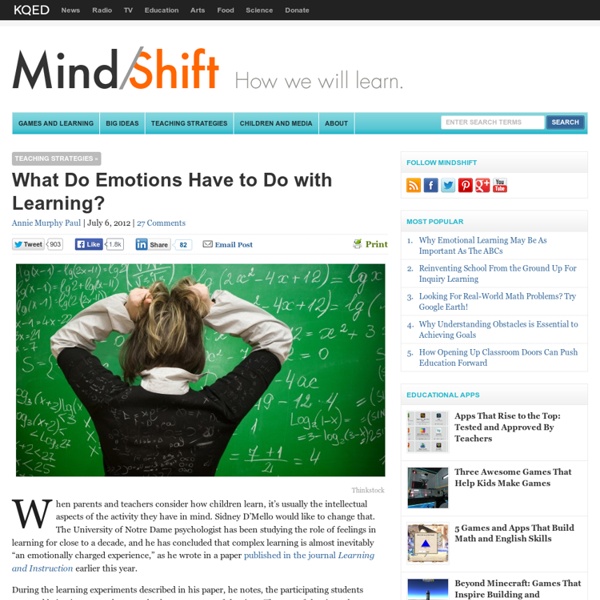8 Ways to Spot Emotional Manipulation.. and Free Ourselves From It
By Paul Lenda Guest Writer for Wake Up World We as human beings have a very strong self-centered aspect (even if it may not be truly ‘real’) of our beings called the ego, and many problems arise when this aspect of the human experience goes uncontrolled. Manipulation has always been a favored tool of the ego in order to get what it wants. This manipulation can come in either a physical form or it can be seen to work on the emotional level in order to break the psyche into meeting the manipulator’s desires. Properly identifying the ways in which people emotionally manipulate others can save us much suffering in the future when identified early enough.
25 TED Talks Perfect For Classrooms
The 50 Best Sources of Free STEM Education Online 12.05K Views 0 Likes Colleges, universities, and other educational forums in your community can be excellent places to learn more about a variety of STEM topics, but there is also a wealth of educational material available on the web for those who prefer to learn at their own pace or take a more individual approach.
Failure: Seeds of Innovation
Lesson Focus Lesson focuses on how failure is part of the engineering process. Students work in teams and learn about many inventions and advances in engineering were brought about after a mistake or failure. Students research an example of such an innovation and develop a presentation related to how the tenacity of the engineer allowed him or her to move past a failure and into the realm of innovation. Students reflect on the value of moving on after a failure or setback, present the results of their research to the class, and provide examples of how the innovation they researched has impacted society -- only because the engineer didn't give up.
Printable Lesson Plan Book Pages & Homework Assignment Sheets
STW Filing Cabinet Logged in members can use the Super Teacher Worksheets filing cabinet to save their favorite worksheets. Quickly access your most commonly used files AND your custom generated worksheets! Please login to your account or become a member today to utilize this helpful new feature. :) [x] close This document has been saved in your Super Teacher Worksheets filing cabinet. Here you can quickly access all of your favorite worksheets and custom generated files in one place!
Inspire Her Mind
Science There’s a young 4-year old girl shuffling through a chest full of various dress-up clothes. The copy asks: Does dress-up determine her future? Scroll to the left, and the girl picks up a princess dress from the chest. She walks over to a mirror and holds the dress in front of her.
How to Use Google Search More Effectively [INFOGRAPHIC]
Among certain circles (my family, some of my coworkers, etc.) I'm known for my Googling skills. I can find anything, anywhere, in no time flat.
8 Uplifting Quotes For Discouraged Students
There are many reasons a student can lose focus in school. It can be bad grades that will discourage them to be inactive and to rebel. It can be the environment that can be stifling and suffocating for the students.
How to teach mind mapping and how to make a mind map
Mind mapping is a visual form of note taking that offers an overview of a topic and its complex information, allowing students to comprehend, create new ideas and build connections. Through the use of colors, images and words, mind mapping encourages students to begin with a central idea and expand outward to more in-depth sub-topics. Mind Map Example Definition of a Mind Map
What’s Your Learning Disposition? How to Foster Students’ Mindsets
Stanford psychologist Carol Dweck’s work on growth mindsets has dominated much of the attention around how students can influence their own learning. But there are other ways to help students tap into their own motivation, too. Here are a few other important mindsets to consider. Belonging to an academic community: Feeling connected to adults and peers at school intellectually, not just socially, through an academic community, is a strong motivator.
Learning and Change Networks: Connecting students with learning
“If you are an active learner, then you think for yourself, but if you aren’t an active learner, then someone thinks for you.” – Primary student. The Learning and Change Network strategy (LCN) was developed to accelerate achievement for students yet to achieve national expectations for literacy and numeracy through future-focused learning environments. LCN involves networks of students, parents, teachers, and community members from multiple schools to collaborate in developing innovative new learning environments. There are currently 53 LCN networks of schools, comprising seven early childhood centres, 19 kura, 285 primary schools, 25 intermediate schools, 30 secondary schools, and 14 Special Education schools. Participation by schools, individuals, and networks is entirely voluntary.



